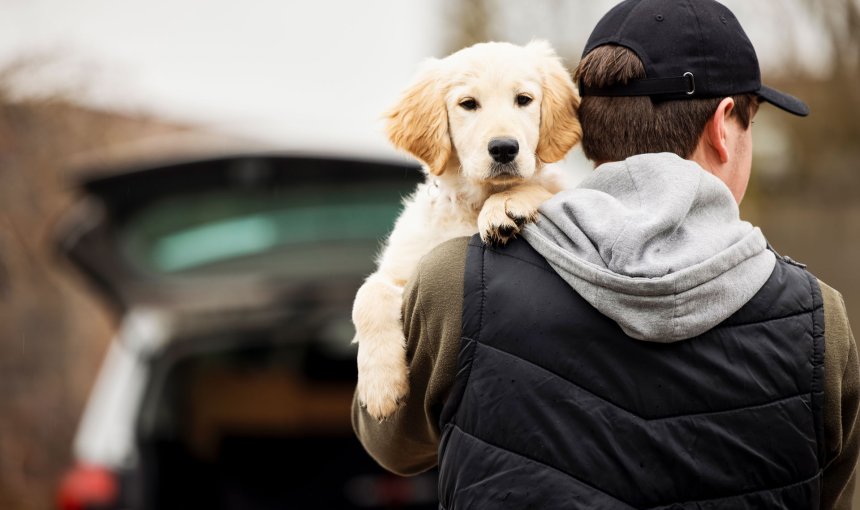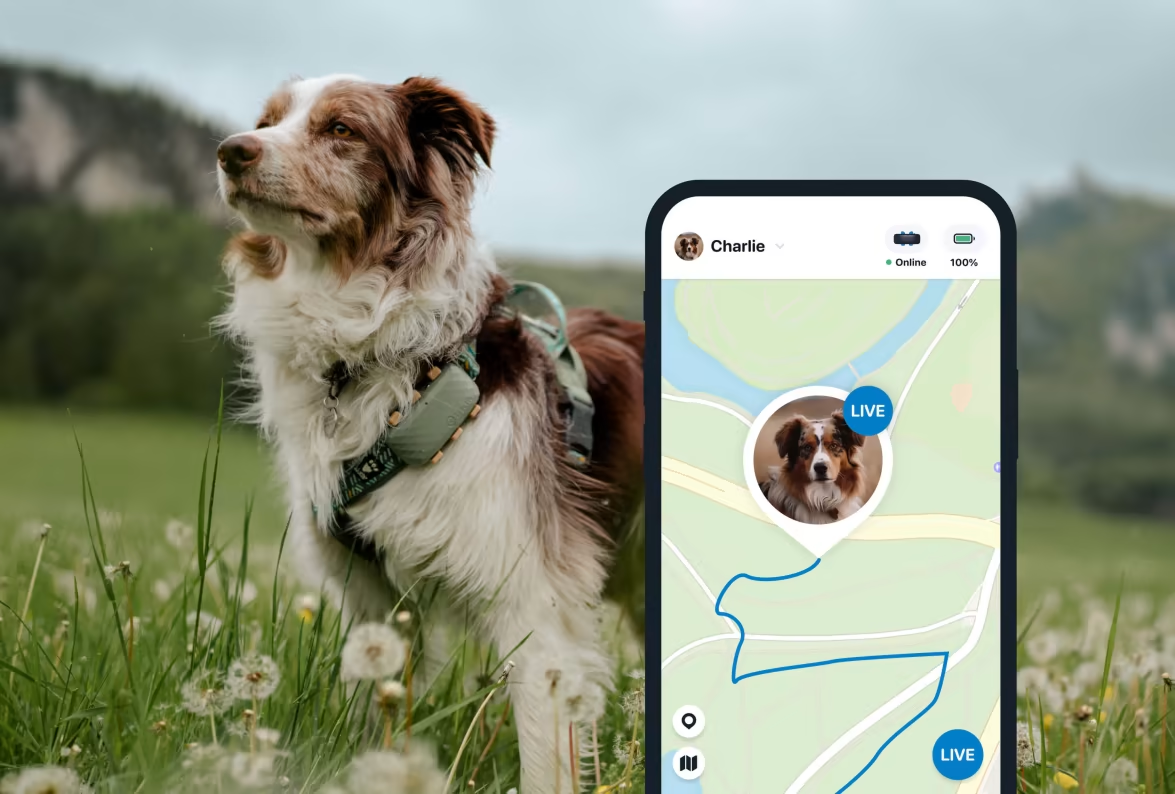Dognapping: How To Keep Your Dog Safe From Dog Thieves
Is your dog a prime target for dognapping? Here are some important safety tips to protect your buddy from being stolen.

Dog theft, also known as dognapping, has increased by 250% since the COVID-19 pandemic began in early 20201. And sadly, it can happen anywhere – from your backyard, to Beverly Hills, to a remote forest in Germany.
Often times, dog thieves don’t have much to lose. Penalties for stealing a dog are minimal in many areas. You on the other hand, might have your whole world in those four paws and curious nose. So let’s talk about how to protect against dog theft and where a dog GPS tracker can be a life-saving emergency measure.

Always know your buddy is healthy & safe
Read more- What is dognapping?
- How common is dognapping?
- What types of dogs are stolen?
- What do dognappers do with the dogs?
- Is dognapping a federal crime?
- How to keep your dog safe from dognappers
- Get your dog microchipped
- Proof of ownership
- Keep ID tags up to date
- Neuter your dog
- Don’t leave your dog alone in a car or at a storefront
- Don’t leave your dog unattended in the backyard
- Choose dog-walkers or dog-sitters carefully
- Keep your dog on a leash when out walking
- Install a doggie camera
- Avoid sharing too much on social media
- Ensure proper training
- Stay informed
- Use a GPS tracker on your dog’s collar at all times.
What is dognapping?
Dognapping is the term used to describe the theft of a dog. It is also referred to by its synonyms, pet kidnapping or dog flipping. Dogs can be stolen from anywhere – your backyard, your home, your car, or anywhere you leave your dog unattended.
Sometimes, dog thieves break into houses just to snatch a dog. Occasionally, armed robbers attack dog owners on the street and make off with the pooch. Dog thieves have even been known to develop elaborate scams to take your pup. Like, for example, these two women who pretended to be an Animal Cruelty Task Force in Los Angeles. Perpetrators of dog theft may use violence, or tactics such as distraction or intimidation.
How common is dognapping?
About 2 million dogs are victims of theft each year in the United States.1 During the COVID-19 pandemic in the United Kingdom and United States, reports of dognapping have surged. Some rural areas of the UK are the worst areas for dog theft. In these places, dognapping has doubled or tripled from pre-pandemic levels, according to police reports.
Sadly, only about 1 in 10 of these stolen dogs are reunited with their families.
What types of dogs are stolen?
Any dog is at risk for dognapping, but pedigreed and purebred dogs top the list of dognapping targets. These popular and expensive breeds may sell for more than $2,000, meaning that dognappers can make a quick profit by stealing and selling these dogs. Here is a list of the most commonly stolen dog breeds:
- Yorkshire Terrier
- Pomeranian
- Maltese
- Boston Terrier
- French Bulldog
- Chihuahua
- Labradoodle
- American Pit Bull Terrier
- Jack Russell Terrier
- Staffordshire Bull Terrier
Other pricey dog breeds, including Chow Chows, Rottweilers, and Cavalier King Charles Spaniels may also be targeted for dognapping because they can be sold for high prices. Small dogs are obviously easier to steal than large dogs. They can be quickly snatched, hidden in a bag or box, and carried away. Large dogs may be tougher to capture because of their size and strength, but the potential profit to be made from selling these dogs makes it worth the risk for a dognapper.
What do dognappers do with the dogs?
Usually, dogs are often taken to be “flipped,” meaning that the dognapper sells the dog as soon as possible after stealing it. Dognapping can be lucrative for the thief: some dog breeds sell for thousands of dollars. Unfortunately, there seems to be a rise in occupationalist dog thieves – people who steal dogs for a living.
It’s not hard to sell a stolen dog. There’s no way to be certain that a dog being advertised for sale isn’t someone’s stolen pet. In fact, experts say that many online ads for dogs that need to be “re-homed” are scams by dognappers.
Dog thieves may respond to a “found pet” notice placed by a concerned animal-lover who finds a dog roaming their neighborhood. The dognapper poses as the pet’s owner and picks up the dog from the helpful neighbor, only to turn around and sell the dog. Sometimes, dognappers adopt a pet from a shelter – not with the intention of providing a loving home, but with plans to sell the pup for a profit.
Petnappers know that dogs are viewed as beloved family members by most pet owners, so they prey upon that vulnerability. These thieves know that owners may be desperate to get their dog back and may offer a large reward. Some thieves may steal a dog and later return the same pup to the owner and claim the reward.
Is dognapping a federal crime?
Although kidnapping a person is a criminal offense, that’s not true for stealing a pet. Most states in the US do not have specific laws penalizing pet theft. Instead, pets are treated as personal property in these states. The law treats your stolen pet the same way it regards a stolen television or jewelry.
A few US states have laws that address dog theft in their criminal codes. But the penalties usually fall in the misdemeanor category and carry only small fines or very little jail time. According to a review by the Michigan State University College of Law, the states of Virginia, Louisiana, Oklahoma, New York, and Mississippi have the strongest dog theft laws.
In the UK, lawmakers in 2021 acknowledged the rise in dognapping and the importance of animal welfare with new laws criminalizing pet abduction. The changes were recommended in a report by the Pet Theft Taskforce.
How to keep your dog safe from dognappers
Get your dog microchipped
Experts agree that having your dog microchipped is the best way to ensure that you are reunited with your dog if they are found after being lost or stolen. Your veterinarian, local animal shelter, or animal adoption agency can microchip your dog by placing a tiny implant, about the size of a grain of rice, under your dog’s skin. Any of these organizations can read the registration information that is stored on the microchip using a handheld scanner.
In the event your dog is resold after being stolen, the unsuspecting new owner may take their newly-acquired pup in for a veterinary check. Using the scanner, the vet could potentially locate the microchip in your pup and tie its registration back to you. Therefore, it’s essential to have your information up to date in the microchip registry. If you move or change your phone number, be sure to update your contact information in the registry so you and your pooch can be reunited immediately.
Warning: a microchip is not the same as a GPS tracker and won’t allow you to follow your dog’s location in real time.
Proof of ownership
Do you have documents that prove you own your dog? These could include, for example:
- Adoption papers
- Proof of purchase from a breeder
- Receipts from buying pet and food supplies
- Recent photos of your dog on your phone or elsewhere
Keep ID tags up to date
If you have recently moved or changed your phone number, be sure to update your dog’s ID tags with the new information right away. If a private citizen is the first person to find your dog, these tags are going to be a major clue that reunites you with your dog.
Neuter your dog
Not only will neutering your dog make them less likely to run away, but it will also make them less of a target for dog thieves, since they can no longer be bred after neutering.
Don’t leave your dog alone in a car or at a storefront
The hazard of a dog overheating in a hot car is not the only reason you shouldn’t leave your dog alone in your vehicle while you are running errands. It only takes a few seconds for a thief to smash a car window and grab your dog. In some parts of the US and the UK, it’s common for dog owners to tie up their dog at a storefront while they shop inside. This clearly makes your dog a very easy target for dognappers, especially if they are a friendly pooch. If you can’t bring your dog into the store, leave them safely at home.
Don’t leave your dog unattended in the backyard
If it’s possible for strangers to see into your backyard, don’t leave your dog in the yard alone. Make certain that the gates in your fence are locked to prevent unwanted entry into your yard. Always try to be outdoors with your canine companion, or at the very least, check on them often. If left alone for long periods, your dog could become bored and get into trouble (by digging or escaping), or worse, be nabbed by a dognapper.
Choose dog-walkers or dog-sitters carefully
If you rely on someone to walk your dog or provide care while you’re away, always check references and use a reputable dog-walking service or boarding kennel. Ask your friends and neighbors for suggestions to find trustworthy services.
Keep your dog on a leash when out walking
Even though it’s a great way to exercise your dog, allowing your furry friend to run off-leash in public areas can be hazardous – for your dog, for other pets in the area, or for other people. Keep your dog on a leash when you are walking them to avoid having your dog run off and into the arms of a not-well-meaning dognapper. A fenced dog park or your backyard (with your supervision) is the only place you should allow your dog off-leash.
Install a doggie camera
With security cameras in your home, you can view a live-stream and monitor your pet’s activity all day long. You’ll always know what your furry friend is up to while you’re away from home.
Avoid sharing too much on social media
Posting images of your dog combined with information that shows where your spend time could make you a potential target for dog thieves. For this reason, police have warned against tagging your location in your social media posts.
Ensure proper training
With the right training, your dog can be taught to stay by your side and obey your cues. If you haven’t already leash trained your dog, learn the basics of leash training here. Training is important for every dog, as it will help you to keep them safe despite their otherwise strong doggy urges, like the prey drive or dog in heat behavior.
Read more: 4 Important Dog Commands & How To Teach ‘Em
Stay informed
Stay up to date on news and events related to dognapping in your area. Be on alert in areas where dognapping cases have occured.. In case the worst does happen and you come home to find your dog missing, follow our steps on how to find a lost dog and bring them home in no time.
And if you want to know where your dog is at all times…
Use a GPS tracker on your dog’s collar at all times.
With a Tractive GPS Dog Tracker, you can monitor your dog’s location at all times and easily find your dog if they should escape your yard or dash off while on a walk. As long as the GPS tracker remains attached to the dog’s collar or harness, you can pull up a map on your phone showing the exact location of your pup and even track them in real time. The peace of mind alone is worth it.

Kathy the Beagle: kidnapped and saved thanks to her Tractive GPS
In Germany, Kathy (aka Käthe) the Beagle was minding her business one day when something remarkable happened. She was off-leash; ready to pass a test in her hunting dog training. The track had already been laid in the forest. As Kathy set off on the trail, her human followed her movements in real time using a Tractive GPS tracker.
Suddenly, Kathy started traveling at high speeds, and way off course. From the Tractive app, it was clear to Kathy’s dad: Kathy had been stolen, and the dognappers were driving off with her in their car! Her father followed his instinct and his dog’s LIVE location in the app. He called the police, and after a dramatic, two-hour car chase, was finally reunited with his beloved Beagle.

Safe to say, it was a miracle that Kathy was wearing her Tractive GPS DOG Tracker that day.



